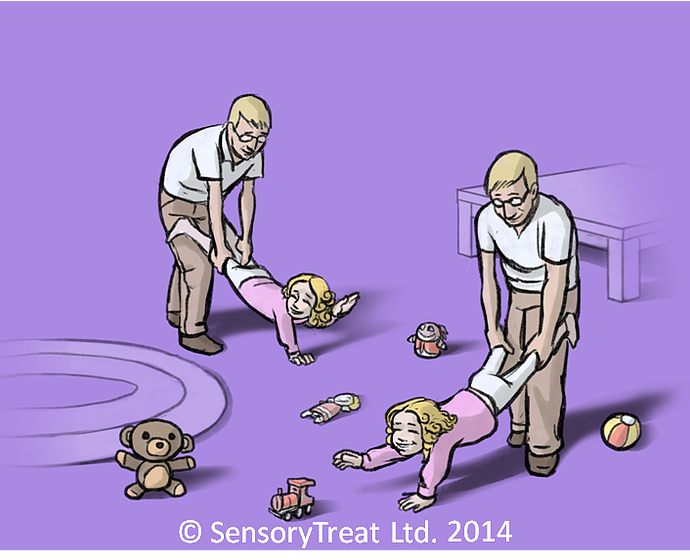
Blend sensory activities into your daily routines
Perhaps the biggest challenge we had was to stick to our children’s sensory diets over time. As a ‘sprint’ it may work, however sensory diet is no sprint, it’s a marathon.
We learned that we had to find ways to integrate the sensory activities into our daily living routines. One day as we were drawing together, it was time for some sensory activity involving heavy work. So instead of stopping what we were doing, I took the marker I was going to hand over to my son and asked him to pull it out of my grip. At first I let him pull it easily, but a couple of markers later we invented a new game: Marker Pulling. We started testing together which color was harder to pull and had a winner for left and right hands and the ‘overall two hands world color championship.’
Whether making this part of bedtime or morning routine, or on the go, it’s all about finding creative ways to blend sensory activities into your daily life.
Make it challenging but not too much
When we started sensory diet with our second child, her occupational therapist told us she needed jumping activities. So we took out the trampoline put her on it and told her to jump. We even modeled for her and explained how to do it. After a few failed attempts she didn’t want to go on the trampoline any more.
The breakthrough came when we broke the task down into smaller ‘baby steps’. At first we bounced her sitting on a large gym ball. Then we bounced her standing up on our bed which always resulted in a lot of laughs and falling together. It was only then that we came back to the trampoline. Despite the fact that it was still us doing most of the bouncing, it was not long before she was able to start jumping on her own.
By looking carefully at what she could and couldn’t do, we learned where her personal boundary lay. We were then able to pace her sensory progress and combine it with a lot of fun.
Keep changing each activity

Not long into each of our sensory diets we noticed some activities were losing their appeal. One of the things our boy liked to do was wheelbarrow walking. However, after a few days we found ourselves working harder and harder convincing him to do the exercise.
We had to come up with some new ways to keep the wheelbarrow exercise which was very effective. So we lined up little toy animals about one foot apart. Now we had a whole new set of activities: saying hello to each animal as we walked by and taking one animal to visit another (lifting one arm made the exercise even better…). Adding hurdles along the way was yet another variation.
We learned that it is always about planning the next change. The moment a sensory activity is ‘adopted’ is the moment we start thinking of new ways to change it to keep the sensory diet interesting.
Make it fun, for you too!

For the most part we enjoyed our kids’ home programs. As long as we kept it interesting for them they loved it, but we can’t say that we were fully into it each and every time (6-7 times a day, 7 days a week…).
One day, as we were carrying our little girl on our back as part of yet another mundane activity, we started playing around by bouncing up and down and running over obstacles. This got her laughing so hard that she kept asking for more. Her laughter together with the challenging exercise made the activity a lot more fun for us too.
When it was time for a sensory activity, we made it a habit to go over our notes looking for something that was still appealing for our child, but more importantly, we were looking for something we felt like doing at that specific time. That’s how our list of sensory diet activities kept on growing.
Manage the therapy process

Soon after starting our first sensory diet we lost track of who did what, when, how it went, what our child stopped liking and where we needed guidance and advice.
A couple of weeks into the sensory diet program our occupational therapist gave us sensory activity papers to fill in. This simple task was a defining moment. It forced us to make sure we executed the plan and logged our child’s responses to each activity. This got us on track. We started doing what we needed and after a while started seeing results. We each had our own system for filling in these forms: one of us wrote in great detail immediately after doing each activity while the other made a habit of filling in (sometimes shorter) comments at the end of each day.
Either way we were able to better manage the sensory therapy process. Making the short time we had during occupational therapy sessions more efficient, and letting our child’s occupational therapist focus more on sensory integration.
‘Good enough’ is just right

Many times during our sensory diet therapies we found ourselves less motivated and energized and often didn’t have time to stick with the home program schedule. Whenever that happened we started blaming ourselves for not doing enough.
During those moments, it was helpful to remind ourselves not to be self-judgmental. Whenever we felt guilty about not executing the plan we told ourselves that expecting perfection is counterproductive and can weaken our ability to maintain the therapy over time. It is okay to take a break and come back re-energized. We then did one small activity, logged it in our daily sensory schedule and never looked back again.
Don’t be hard on yourself, pay attention to what triggers difficulties in maintaining the therapy regimen. Remember, it’s not about one specific activity, day or even week, it’s all about the ‘big-picture’: doing a good enough job over time, is just right!
